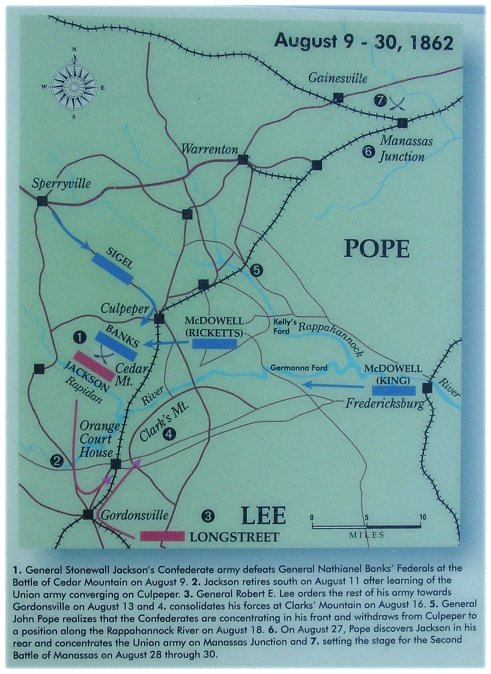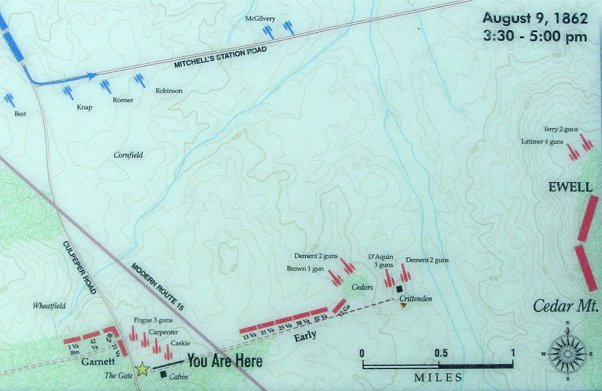Cedar Mountain
August 9, 1862
George McClellan largely ended the threat to Richmond
with
his withdrawal to the James River during the Seven Days Campaign.
Another
Union army, however, was forming in
Northern Virginia under John Pope, a hero of the Western Theatre. Robert E Lee sent Stonewall Jackson north
from the Richmond area to
Gordonsville to "suppress" Pope, whose policies toward the civilian populace
were a departure from McClellan's more traditional views. Jackson
patiently waited for an opportunity to strike.
The secretive Virginian was reinforced by A.P. Hill's Light Division, but
Jackson
remained
outnumbered by Pope, who would eventually be reinforced by McClellan's army
arriving from the Peninsula. As you can see from the map, by early August,
the time had come for the Confederates to strike. The Union corps were spread out. On August 8th Jackson attempted an advance on a portion of Pope's army
under Nathanial Banks,
but this
miscarried because of a controversial miscommunication with Hill, which lead to the
famed feud between the two. The advance toward Culpeper, however, continued on August
9th. In the mid afternoon the Confederates encountered Union forces near
Cedar Run. In the battle that followed, 12,000 Yankees under Nathaniel
Banks pre-emptively attacked Jackson's 22,000 men. Despite the advantage
of numbers, Jackson would be hard pressed to hold his army together under a
savage Union attack.
|
 |

From "The Gate"
| Jubal Early lead the first
Southern brigade to arrive, finding Union artillery to the front.
Additional Confederate troops arrived and extended both flanks, with the right
under Ewell firmly anchoring the army's flank on Cedar Mountain. Confederate infantry under Early were in position down Crittenden
Lane on the right of the panorama above, extending to the Crittenden House. Cedar Mountain, Ewell's position, can be
seen in the distance on the right. Taliaferro's brigade joined Early near the lane.
Garnett's brigade was deployed along the Culpeper Road - the one visible on the
left of the pan
with the prominent fence. Further forward Garnett's line angled to the left,
so that it was parallel
to the Crittenden Lane once again.
(See map.) Artillery was placed on high ground at "The Gate" between Crittenden
Lane and the Culpeper Road. Here the guns were in position to
fire either to the front - or to the right to protect Early's line with enfilade
fire. Jackson allowed himself to become
distracted by a duel with the Union guns - becoming too involved with his
artillery while neglecting his infantry. The same was true of General
Winder - killed by a Union artillery round and replaced by Taliaferro.
Meanwhile, the Confederate left was "in the air", meaning that it wasn't
anchored on any natural obstacle. Although the 10th Va and the
Stonewall Brigade had been sent to reinforce the flank, they never connected
with Garnett. Preoccupied, Jackson didn't know this, and opposing line
of Union infantry overlapped Garnett's line. |
 |

Wheatfield - Garnett Attacked by Crawford
Much of Garnett's brigade had been deployed on this slope on the left of the Confederate line, in
a line roughly parallel to the signs - facing toward the ravine to the front.
Cedar Mountain is visible on the right. The 10th Va and the Stonewall
brigade were to the left rear in Brushy Field visible in the distance on the
left of the picture. Goaded by the Confederate artillery, Banks ordered his outnumbered Union army to attack.
Crawford's brigade of Alpheus Williams' Yankee division struck near here, the most forward section of the rebel line.
The Federals exploited the exposed flank of the Garnett's line, pushing the
Confederates back through the
woods to their rear in hand-to-hand combat - and not always taking prisoners. It looked like
Jackson would suffer an embarrassing defeat.

Early Attacked by Auger
| This is the view from just in front of the
center of the Confederate line. The Gate, where the Crittenden Lane
left the Culpeper Road at a 90 degree angle,
is on the left of the panorama, with the old Culpeper Road visible as a fenceline from left to right.
Crittenden Lane was parallel to the treeline on the far left. It crosses
Route 15, which is a modern road, and extended to the Crittenden House,
presumably near the silo visible below Cedar Mountain. (See the right
side of the panorama.) Early's brigade
was deployed parallel to this lane, and Ewell and some guns were on
the slopes of Cedar Mountain. While Crawford was
pushing back Jackson's left in some woods beyond the Gate, Union troops
of Auger's division were advancing through a Cornfield and were attacking Early.
Geary's brigade attacked here near modern Route 15, with Prince's brigade
attacking closer to the Crittenden house. Confederate artillery at
"the Cedars" near the Crittenden farm was withdrawn, as were the guns near
the Gate, which were threatened from two sides. In addition to
pressure from the front, Taliaferro and Early were threatened on their left
flank as Crawford's successful attack began to swing into them. The whole Confederate line
was under great pressure, and Jackson drew his sword for the only time during the
war to try to rally his men. Only the timely arrival of AP Hill saved
the Confederates, much like events at Sharpsburg the next month.
|
 |

From Near Original Union Line
With reinforcements arriving, Early held on and repulsed
the attack. AP Hill's division was on line, and the Confederates went on
the attack, forcing the Yankees from the field. The Confederates on the
left repulsed an isolated attack by the 1st Pa Cavalry. One of the rare
cavalry attacks on infantry early in the war, this one failed like most of the
others. It was outnumbered, unsupported, and was used in an act of desperation.
Mitchell's Station Road on far left and far right of
this panorama, roughly marks the original Union line - or jump-off point of
their attack.
The Federals fell back to this line after their repulse. The right of the Confederate line
had originally ended on Cedar Mountain, but the Southerners were now advancing.
Facing a strong Confederate attack, the Federals withdrew from the field.

Cedar Run Church
With night falling, the Union rear guard made a
stand north of Cedar Run Church. Confederate artillerist Willie Pegram was
heavily involved in this action.
Jackson had lost around 1,300 men compared to Union
losses of around 1,400, and his attempt to destroy the Union army
piecemeal had failed. Heavily influenced by his personal
involvement - rallying his men - Jackson felt that the battle was a great success. He withdrew south a few days later to join up with
Lee, who was bringing his army north from Richmond. Combined, they would
oppose Pope's army, and hopefully destroy it before McClellan's Army of the
Potomac returned from the Peninsula. Later in the month, in an amazing
campaign, Lee and Jackson would march into the rear of the Union army and fight
difficult battles at
Brawner Farmer and Second
Manassas, nearly destroying the despised John Pope and his army.
Back to Civil War Virtual Battlefield Tours







